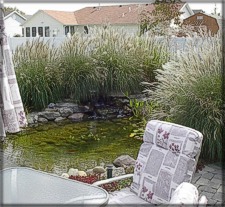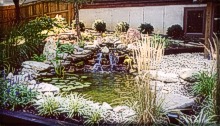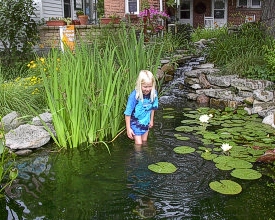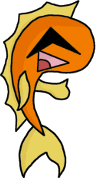Water Gardens
Water Gardens fit well into all types of landscaping, costing the same as a similarly sized deck or patio. With the help of Sulina Farm Aquatic Environments design consultants, water gardens can be personalized to fit the owner's idea of paradise. If you are on a budget like most people, design consultants can help you plan your dream yard in stages. Stretched out over time, you can budget each stage of installment.

The Sulina Farm Aquatic Environments technique is based on the idea of a miniature, environmentally sound “ecosystem,” usually taking only a few days to complete. To achieve this, we use the Aquascape Designs Ecosystem developed by Greg Wittstock. This system is the latest in pond technology and is the absolute best in residential or commercial water gardens. Each Aquascape Designs water garden kit includes a mechanical and biological filtration system, pump, 45 mil EPDM liner and underlayment, underwater lighting, BIOFALLS, skimmer, check-valve, PVC flex plumping, installation kit, waterfall stone , skimmer rock, filtration media, skimmer bags for lava rocks, owners manual, and bacteria to keep the water sparkling clean. Requiring much less work than a lawn of similar size, they are also much more rewarding.

What is the secret to a successful pond?
From the beginning, many people have come to me with stories of green water and dying plants or fish. They have spent hundreds of dollars with the expectation of having a crisp clean water feature that they can show off to their friends, only to find that they end up with a mosquito farm instead. Many of the books you read have a deluge of information for the up-starting pond owner, but do not write about the most important parts of the pond or don't give the reader the whole story. Sadly, many people don't realize this until it is too late. I know I'm one of them.
I have found out that there are three major parts to a pond. The pond eco-system includes (1)water, (2)plants and algae, (3)fish and other inhabitants of the water. The problem is that many ponds are built with some of the most important aspects of the eco-system missing. It is only when all the parts are working that the pond will keep your water clean.

The first thing that a pond owner must do is establish a system that can sustain bacteria in the water. The bacteria will play the leading role in keeping the water clean. It does this by consuming the nutrients that feed the algae that turns the water green.
Many of the ponds built today don't have enough filter area or bacterial growth media to keep adequate amounts of bacteria alive in the water. One way is to build an area in the pond where large volumes of water will pass through, such as a bio-filter. Inside this contained area, place material that can be used to grow bacteria, such as lava rocks. The porous rocks are the ideal place for bacteria to grow. Other types of material that can be used are ceramic pieces, fiber-strands, or a sponge type filters.
In order to keep the bacteria alive, the pond must keep adequate amounts of oxygen in the water. The oxygen is added to the water by the surface exchange when the water is being pumped over the falls or when an aerator is used to pull water from the bottom to the surface. This water must also be pumped though to bio-filter area to insure that the bacteria is receiving the proper amounts of oxygen from the water.

But all this still isn't enough to keep the bacteria alive. It will need a place to live and colonize. This is why Mother Nature put gravel at the bottom of streams and rivers. The bacteria will live in the spaces between the small rocks so when nutrient rich debris lands on the bottom, it can be consumed by the bacteria. Ponds without any type of gravel on the bottom will build up a slimy black sludge that will increase the maintance of your pond.
To help Mother Nature along, bacteria made just for water gardens can be purchased at most local pet stores. Bacteria should be added only according to recommended dosages. Dry bacteria, which is the best type to use, is usually added to water at a rate of one teaspoon for every 1000 gallons. For new ponds, dry bacteria should be applied every other day for the first two weeks. This dosage should be repeated every 14 days once the bacteria is established.
This is where the other elements of the pond can help Plants and Fish. Plants will consume nutrients and produce oxygen, becoming, as they grow, a major player in the warmer months of the pond. Aquatic plants do this by competing with the algae for the nutrients. In larger ponds with high volumes of water, bog-filters can be built. A bog-filter is like the bio-filter mentioned above, but is filled with pea-gravel. Marginal plants are then planted on the surface which allow the roots to grow down into the gravel. As the water passes through the gravel media, the roots will consume the nutrients.

Algaecides should never be used in water gardens as a means to control algae. This type of product is only a temporary fix to the problem and will not cure the overall problem. Once the algae is killed off, it will sink to the bottom and as it decomposes, release its nutrients in the water. This will make the next wave of algae even stronger and harder to control. This type of method makes the pond dependent on chemicals to control algae.
But plants are not all work and no play. They can also add to the pond in other ways. If not shaded from the hot summer sun, a pond's temperature can reach as high 95 degrees. This is very stressful for the plants and the fish. Plants such as lilies can provide shade and places for the fish to hide.
One last thing, not all algae is bad. String algae or filament algae is a good sign that the pond eco-system is working and that the pond is healthy. It is this algae that the fish will eat ,so you don't have to worry about feeding your fish. Some ponds can produce large amounts of string algae which can be controlled by stocking your water with large Koi fish. These fish will consume large amounts of the algae, keeping it under control.

If there is a body of water, there must be fish in that there water! The fish in your pond will help naturalize your water by acclimating certain elements to your pond. They will eat the algae that grows on the rocks and any insects. Their waste will be used to fertilize any plants and help keep the them healthy. Beneficial bacteria can also use fish nutrients as a food source.

Fish can become the perfect pet in water gardens that have all the elements to keep the water clear, allowing you to gaze at them all year long. Yes, during the winter most fish will be just fine outside. The only major requirement is to keep a hole in the ice so that poisonous gases can escape. It is during these cold months that fish don't eat as much, so feeding them is not necessary Even during the summer months, the fish still have the algae to eat. The two types of fish for water gardens are the Koi fish and the Comet Goldfish. Both fish can live in water as low as 32 degrees. Other types of fish, such as the Fan-tail or Lionhead will need to be brought inside. The other drawback is that these types of fish move slower in the water and are more susceptible to predators.
“If you build it they will come.” Water will naturally attract other creatures. Don't be surprised to find frogs or snails in your water garden, they are part of the eco-system and can be beneficial to your pond health.
To Summarize, WATERFLOW + GRAVEL + PLANTS + FISH + OXYGEN + BACTERIA + LESS NUTRIENTS = CLEAR WATER.

